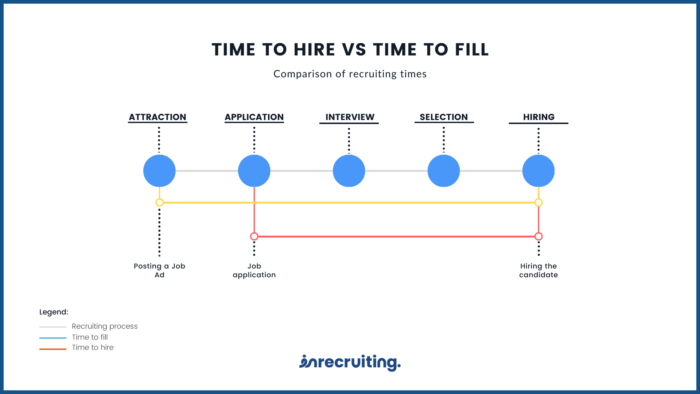
Time to hire and time to fill: enhancing recruiting time in the company
The search and selection process involves several activities, some more complex than others, which can sometimes result in rather long recruiting times. In addition to this, secondary factors (location, time of year, job position offered, structure of the ad, publication channels, etc.) can affect the timing and success of the selection. Monitoring time to hire and time to fill (among the main recruiting metrics) is fundamental to understanding how to improve your recruiting strategy.
SUMMARY
- Time to fill VS time to hire in the HR industry
- Timing of Selection and Hiring in the Recruiting Process
- Give value to recruiting time with an ATS
- Time to hire, time to fill and artificial intelligence
Time to fill VS time to hire in the HR industry
What is time to fill?
Time to fill refers to the period of time from the publication of an ad to the acceptance of the job offer by the candidate. Theoretically, it is possible to talk about time to fill when a company expresses the need to hire new staff and begins the search, but to calculate it concretely, it is necessary to start from the actual publication of the job offer.
The time to fill has a wider spectrum than the time to hire: it also includes the time dedicated to the first stages of talent attraction, which is crucial for the first interaction of the candidate with the recruiter or for the registration to the job offer.
What is time to hire?
Time to hire, on the other hand, is the time that elapses between a candidate registering for an ad and actually being hired. In order to talk about time to hire, it is necessary that the candidate has taken a concrete action: that he has submitted his application or, if we are talking about passive candidates, that he has interacted with a recruiter and that this contact has influenced the registration to the ad.
In this case, the time to hire begins the moment the candidate enters the hiring pipeline (the path that tracks the progress of the candidate’s selection status) and ends with hiring. You can say that time to hire is the time it takes the candidate to traverse the hiring pipeline and can coincide with their application journey.

Timing of Selection and Hiring in the Recruiting Process
Analyzing these KPIs allows recruiters to gain insight into the effectiveness of their recruiting strategy. There are no universal benchmarks against which to compare your selection and hiring times, but you can monitor their progress to assess which recruiting strategy has proven most effective. Obviously, we must not forget that, as we said at the beginning, there are many elements that can affect the success and timing of recruitment.
In detail, the analysis of the time to fill allows to optimize the duration of the next recruiting campaigns or, in the case of a new research of personnel, even just to have an indication of the time we should expect to close a similar research. By monitoring time to hire, on the other hand, it is possible to improve selection management also in economic terms. To avoid hastily choosing the wrong candidate and incurring greater expenses than expected, the selection time should be neither too short nor too long.
Give value to recruiting time with an ATS
If you are in charge of human resources, you should never underestimate the importance of recruiting time. To optimize the selection process in the company, in fact, it is necessary to analyze time to hire and time to fill and understand how to value them.
A first big help can come from the use of recruiting software. An ATS (Applicant Tracking System) such as Inrecruiting allows both to manage the entire selection process and to monitor the time directly within the application.
By consulting the statistics area, it is possible to view the time to hire and time to fill of a specific job ad (after defining and tracking the hiring of a candidate) or the average time recorded on all ads posted.
As we know, although it is important, it is not enough to just write a good ad to find the person we are looking for! By choosing to use an ATS, you can take advantage of a number of features to support the work done by the recruiter, which can affect better time management. Among the most impactful ones, we talk about:
- Multiposting of ads on numerous free and/or paid Job Boards and social platforms such as LinkedIn or Facebook, to intercept candidates engaged (and not) in job search
- Centralized database where all the applications received are stored
- This can include tools such as questionnaires and systems for scheduling interviews and video interviews. In the latter case, delays and organizational problems related to the candidate (off-site) or the recruiter himself would be solved
- Advancement of selections in the Hiring Pipeline to identify any slowdowns and monitoring of recruitment to get a more realistic view of recruitment timelines.
Time to hire, time to fill and artificial intelligence
The speed of activities is one of the factors that has the greatest impact on time to hire and time to fill. And we’re not just talking about those carried out by the recruiter, but also by the candidate. For this reason, artificial intelligence (AI) is definitely an element that can have a decisive impact on recruiting time. Artificial intelligence technology such as Inda (Intelligent Data Analysis) makes it possible to automate certain activities: automatic filling out of application forms, CV screening, automatic data entry, semantic candidate search, etc.
By speeding up the time to work, AI provides the recruiter with the technologies needed for a process to be set in motion to identify the right and most qualified candidate for a job posting in the shortest possible time.

Digital Marketing presso Inrecruiting